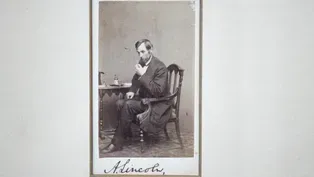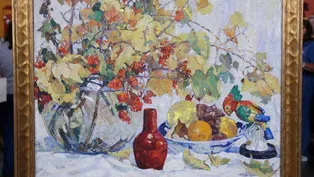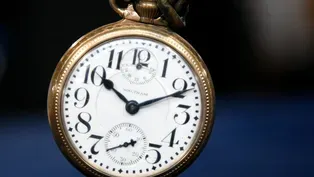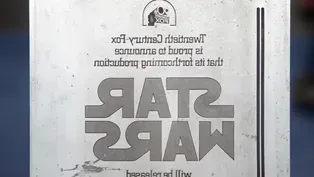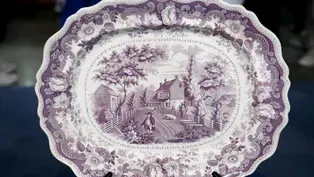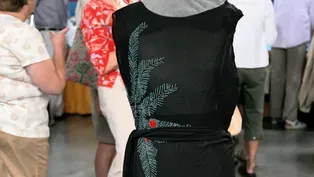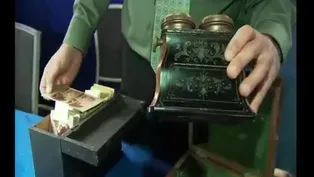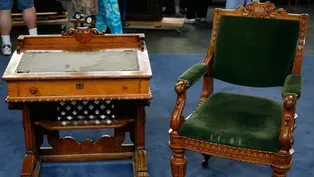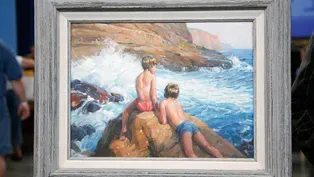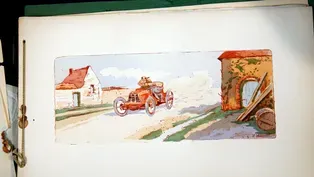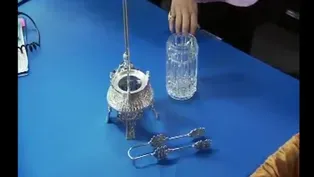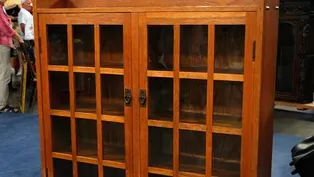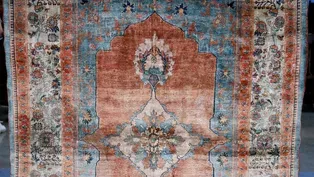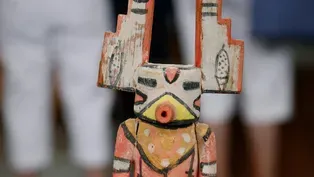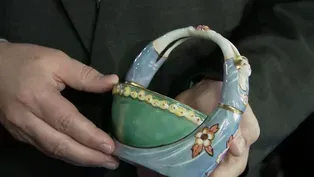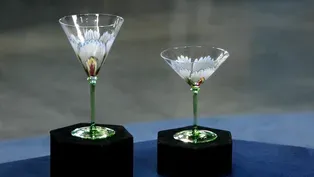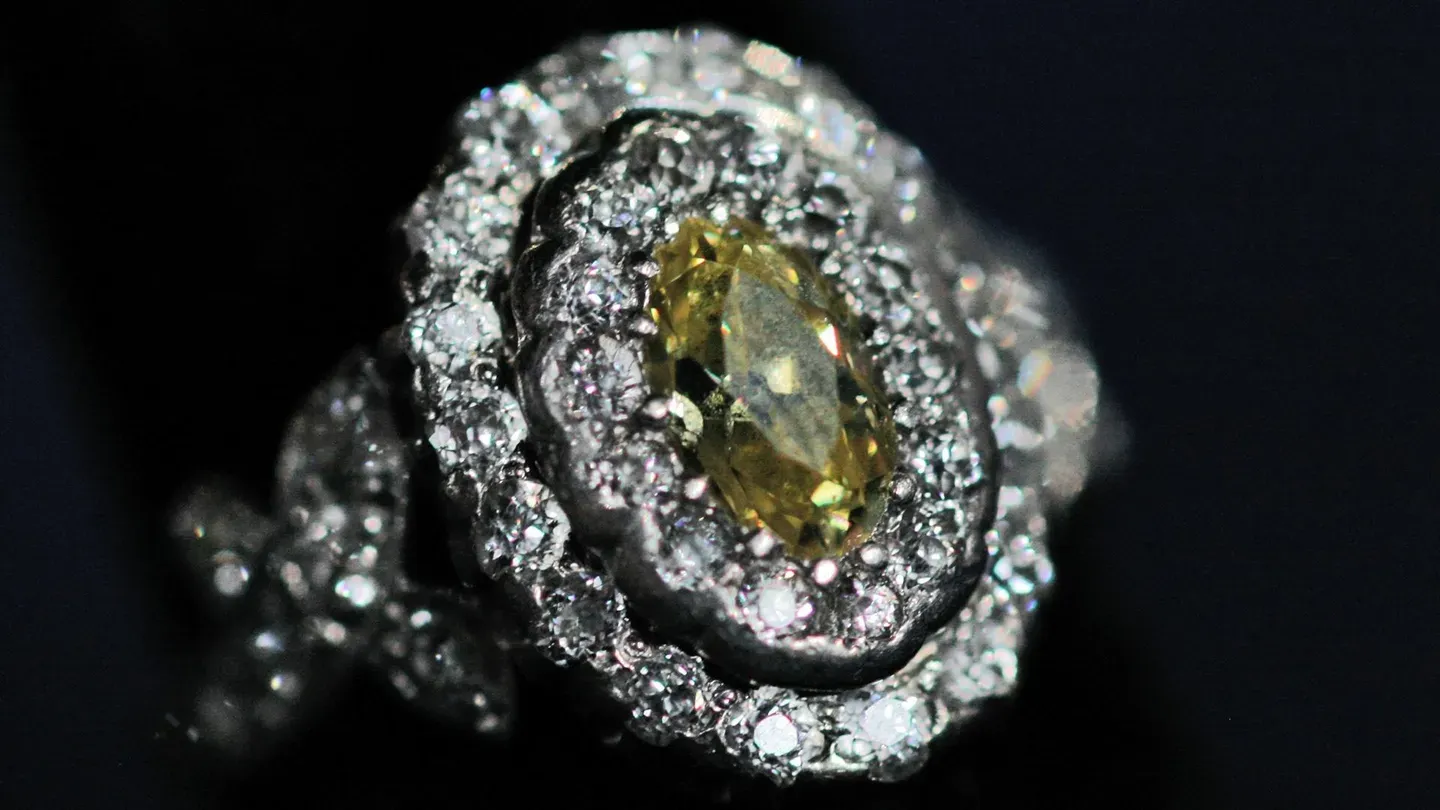

Vintage Spokane, Hour 1
Season 25 Episode 8 | 52m 29sVideo has Closed Captions
Discover what Spokane finds from Season 12 are worth now, including a $80K-$120K standout!
Discover what Spokane finds from Season 12 are worth now like a 1905 Spokane bird's-eye view lithograph, Abraham Lincoln letters and signed carte-de-visite, and a yellow diamond and platinum ring. One has an updated appraisal of $80,000-$120,000!
Problems with Closed Captions? Closed Captioning Feedback
Problems with Closed Captions? Closed Captioning Feedback
Funding for ANTIQUES ROADSHOW is provided by Ancestry and American Cruise Lines. Additional funding is provided by public television viewers.

Vintage Spokane, Hour 1
Season 25 Episode 8 | 52m 29sVideo has Closed Captions
Discover what Spokane finds from Season 12 are worth now like a 1905 Spokane bird's-eye view lithograph, Abraham Lincoln letters and signed carte-de-visite, and a yellow diamond and platinum ring. One has an updated appraisal of $80,000-$120,000!
Problems with Closed Captions? Closed Captioning Feedback
How to Watch Antiques Roadshow
Antiques Roadshow is available to stream on pbs.org and the free PBS App, available on iPhone, Apple TV, Android TV, Android smartphones, Amazon Fire TV, Amazon Fire Tablet, Roku, Samsung Smart TV, and Vizio.
Buy Now

ANTIQUES ROADSHOW 2025 Tour!
Enter now for a chance to win free tickets to ANTIQUES ROADSHOW's 2025 Tour! Plus, see which cities we're headed to!Providing Support for PBS.org
Learn Moreabout PBS online sponsorship♪ ♪ I've seen windmill salesman samples before.
I've never seen anything so fantastic.
That is... That's very naughty.
I know.
I know, it is.
Wow, really?
Holy Toledo!
Whoo-hoo!
♪ ♪ CORAL PEÑA: When "Roadshow" visited Spokane in 2007, folks from all over the Pacific Northwest scoured their attics and dusted off their treasures to get the lowdown from our experts.
14 years later, have the values for these items held strong or headed south?
Let's find out in part one of "Vintage Spokane."
MAN: It's a kachina doll.
It was my father's.
He taught school in southern Idaho during the '20s, when they relocated tribal people from different places.
They sent children all over the United States, and this young man became a friend of my father's, and, and when he left school, he gave my dad the doll, so... Do you know where it came from?
From hearing what my dad talked about and what he said, you know, that it was from Southwest America somewhere.
It's from northern Arizona.
Northern Arizona?
It is a kachina doll, but there's some different things about this one that makes it a little bit special.
It's not like most kachina dolls.
We actually know who made this doll.
Oh, really?
Yeah.
It was made by a guy named Wilson Tawaquaptewa.
Oh, my goodness.
And he was the Hopi chief at Oraibi, but there's two Oraibi villages, and I'm not sure which one it was.
See, that name sounds familiar.
Yeah, but... Because he was the chief, he wasn't going to do something traditional and sell it, and so he made these kachinas that are like no other kachinas.
Really?
You go through the books and you're not going to find one of these, because they most often represent a badger, or they have characteristics of a mouse or some animal in his world out there that's not a traditional kachina, and this is one of them.
The way that we spotted it is, he liked to use this indigo color, and...
It's this really faded blue here.
I never noticed it.
Yeah, we almost didn't, too.
(laughs) Tawaquaptewa worked from about 1930 into the early 1960s.
If it wasn't one of his and it was a kachina that looked like it was from the '30s, like this one, that's worth some pretty good money-- $2,500... Oh, my goodness.
...to $3,500.
But because it's a Wilson Tawaquaptewa, there's a group of collectors now who recognize his work, who buy his work.
On a bad day, this is worth $7,500 to $8,500.
Uh... (chuckles) If it's a good day and the right collector's in the room, $9,000.
My goodness.
So it's something real special that you ended up with.
Oh, no kidding, and to know that you can recognize the maker, you know... Yeah.
That is, that is amazing.
That surprises me, surprises me a great deal.
Great.
Yeah.
(laughs) Yeah, it does.
WOMAN: This is my father's pocket watch, and he wore it every day that I can possibly remember, and has this little leather thong on it.
He was a cattle rancher down out of Ritzville, and he wore it on his belt loop, in his pocket, and he didn't wear a regular watch because he worked so hard that he would break a regular watch, like, in three or four days, so he wore it always when he was, like, baling hay or driving tractor or throwing calves.
Let me tell you about the watch a little bit.
It's made by the Waltham Watch Company...
Okay.
...in Waltham, Massachusetts, all right?
They started in Roxbury, but they soon after set up shop in Waltham.
They went into business in the mid-1800s.
They went out of business in 1957.
Really?
Yes.
So this is old?
Yeah, sure.
Now, at the end of production, they made approximately 35 million pocket watches.
Oh, okay.
So there's a lot of them out there.
Yes, it is.
Now, let me tell you about yours.
It's a railroad watch.
It has these large Arabic numerals.
Down below, you have a subsidiary second hand.
But did you ever notice the other dial up on top of the watch?
Yeah.
Do you know what it's for?
No.
What it is, is it's a wind indicator.
When you wind the watch, it tells him how much power is left in the winding mechanism, so it wouldn't run out accidentally.
Huh!
It's an added feature.
It's the kind of thing you don't see on every railroad watch.
Now what we want to do is, we want to turn it around.
Okay.
What we're going to do is talk about what makes this watch a little better than the average open-face railroad watch.
In the center is a diamond end stone.
Usually, they're synthetic rubies.
Is it a real diamond?
It's a real diamond, yes.
Ooh!
We see over here it's a Waltham Vanguard.
Okay.
And then we travel over here, and it tells us that it's 23 jewels.
23 jewels is a nice option.
A lot of them are 21.
And then we go up here and we see that it's six-position.
A lot of them came five positions.
Mm-hmm.
So these are just... All those little bells and whistles...
Wonderful.
...that add up and tell us that it's a quality watch.
Uh-huh.
Great.
Let's turn it around.
Isn't that something, that a rancher would have a railroad watch?
And a very high-end one.
Yeah.
If you have to go out and buy this watch again today, I feel you would have to pay somewhere between $3,000 and $5,000.
Holy Toledo!
Whoo-hoo!
(chuckles) That's wonderful.
You're kidding?
I'm not kidding you, no.
I mean, he banged this thing around every single day on this thong, just tied to his...
This is wonderful!
Thank you!
I'm so glad you're happy.
Oh, I love it.
Thank you so much.
You're welcome.
I inherited this from my aunt, and she inherited it from her aunt.
Okay.
So it's my great-aunt.
Do you have any idea if she wore it, or when she wore it, or anything about it?
No, I don't.
Actually, we thought it was the flapper period from the '20s.
Uh-huh.
And it's such a tiny dress, none of us have been able to wear it.
Oh, you haven't been able to?
I wish.
I would have thought you could wear it.
Well, thank you.
It's a wonderful dress.
It's probably from the Art Deco period, which is between the two world wars, roughly the 1920s and '30s.
And when we think about Art Deco, we usually think about geometric designs.
Right.
But we also think about rather exotic themes, which is what you have here.
You can see that we have this wonderful palm tree all done in hand-sewn beads with a waterfowl of some sort down here.
All of this is done by hand.
The design is very simple but very sophisticated.
Unfortunately, there's no label on the dress, so we really don't know who made it.
But whoever did was certainly an artist.
Would you have any idea of the beadwork, or where the beads came from?
They're European.
European?
Probably Czechoslovakian.
And one of the great things about this dress, it's done on, like, a very thin silk crepe.
And these beads weigh a great deal.
Yeah.
And it's quite unusual to find a dress like this where you have this beaded area all around the bottom, and all the weight of these beads, and for the dress to be in such excellent, excellent condition.
We just had it in a box.
With tissue?
No, no, just, just a box.
Okay, well, I would like to encourage you not to put it in a box.
Oh, okay.
I would put it either in acid-free tissue, or you could even put it, like, in a white cotton sheet.
Since it's in your family, you're probably not going to sell it.
Right.
And you'd probably like to know the insurance value, right?
Mm-hmm.
So, for insurance, somewhere around $1,500 to $2,000.
Oh, really?
Because it's so unique.
Oh.
Because the condition is excellent.
Well, that's great.
Thank you for bringing it.
That's good.
Well, my brother called me this morning and said, "Bring the dress."
I couldn't think of what to bring.
WOMAN: They were my grandfather's, and then they passed to my father, and now they belong to me.
Well, both banks were made by the same manufacturer.
Okay.
Made by the Shepard Hardware Company in Buffalo, New York.
It was the rage in the late 19th century to start creating these mechanical banks, these penny-saving devices.
Mm-hmm.
And we have two really nice examples.
An interesting thing about all Shepard banks is that they didn't use a primer before they put on their finish coat.
Mm?
So it's very difficult to find a lot of Shepard banks in good condition.
And, as you can see here, with the trick pony, you can see a lot of losses of paint, and that's quite typical of Shepard.
This is what I would consider slightly above-average condition, not the best condition.
Okay.
Yeah.
I've also loaded it with a penny so we can see the action, so we'll do that right now.
Oop!
(chuckles) And he drops the penny in.
There it goes, yeah.
And you can have that penny.
Thank you.
(laughs) And this bank was designed by Charles Shepard and Peter Adams in about 1885.
And it was in production for many years, up to around 1900.
So a nice trick pony like this, the value is $800 to about $1,000.
Mm-hmm, okay.
Now, this Shepard bank has an iconic image: Santa Claus.
Absolutely, yeah.
And it has a wonderful action to him.
I mean, he's dropping the penny in the chimney.
We'll go ahead and show you that now.
Okay.
So that's how that one works.
A very simple mechanism.
It's all cast iron.
This was also designed by Charles Shepard and Peter Adams, in about 1889.
Now, it's so important, with all mechanical banks, and especially Shepard, that they have a lot of paint.
And that's how we grade and figure out what a good mechanical bank is worth.
Okay.
It is what I would term as excellent.
Ooh, good.
It's not near-mint, but it is a really nice example.
So, value-wise, you have any idea?
I... Have you ever had the banks looked at?
No clue-- I know my dad just coveted them and took care of 'em and, you know, was very careful with them, and that's all that I know.
Considering the condition of this bank, I would say an auction estimate would be $3,000 to $4,000.
Wow!
Really?
Yeah.
Oh, God, he would be so pleased.
Oh, that's wonderful.
It's American majolica.
And it may be Owens Pottery, which made really over-the-top, crazy majolica.
It's about a $3,500 piece.
Yeah.
This is, like, fabulous.
APPRAISER: Did you know there was a big large-folio version of it?
WOMAN: I knew there were many different versions.
To make it more readily available, this great book about the Indian tribes of North America was issued in a sort of handy size with the same quality, marvelous hand-colored lithograph plates of the various Indian leaders.
Mm-hmm.
This three-volume set would have an estimate at auction of about $15,000 to $20,000.
Okay.
Wow.
This is something that I've had since I was really tiny.
And it's sort of like an olden-day View-Master.
Uh-huh.
You put a slide in there and you look through it and it gives a 3D image.
Okay.
What you have is a Brewster stereoscopic viewer.
This is a relatively late one.
It was probably made in England, but the earliest ones of these were made in the 1850s.
You were telling me you like these because there were some naughty views in here?
There are some naughty Victorian ones in there, yeah.
Oh, my gosh.
That is... That's very naughty.
I know.
I know, it is.
This, in the original box, is worth about $800 to $1,000.
Wow.
It would be worth more, but the oculars are cracked.
Yes.
The thing that I'm sort of interested in is, how did these American stereo views get in here?
I have no idea.
How did we let those Yanks into my slide books?
Well, these are very important American stereo views, too.
Okay.
These are from the Fisk expedition at 1866, crossing the plains to Montana.
That slide is probably worth about $200 or $300.
Oh, my gosh.
The total value of the box that you have here... Mm-hmm.
...is several thousand dollars.
I haven't added them all up.
Oh, wow.
So you've got quite a little group of...
I'm glad I came today.
So what did you bring in for us today?
Um, sword, pistol, and picture of my great-great- grandfather.
Who was...?
Captain William T. Swain with the Union Army.
Who did he serve with?
The 12th Illinois Infantry out of Tiskilwa, Illinois.
The hat has the hunting horn design on it.
That's the symbol for the infantry branch of the service.
And in the center of the horn is the number 12, for the 12th Regiment.
On this side, we have his Colt revolver.
On this side, we have his sword.
We have his pistol and we have his sword; the actual pieces that he had in the picture.
Did he survive the war?
No, he fought in four battles.
Shiloh was the last one, where he was mortally wounded.
Right, Shiloh, in April 1862.
How did the pieces make it home?
After he was wounded, they put him on a boat going back up the Tennessee River, where they were going to take him back home.
A couple of days later, he died on the way home.
From the infection?
Yes.
April, hot month.
They buried the soldiers right away.
They buried all the soldiers in mass graves.
If they hadn't have put him on that boat and sent him home, these pieces wouldn't be with us today.
And the pieces that we have, we have a Model 1851 Colt revolver.
It's a Model 1851 Navy, even though infantry and cavalry used it more so than the Navy.
It's a .36 caliber, and fortunately, Mr. Colt kept good books.
If you notice, it has a 103 serial number.
That means that this gun was made in 1861.
It has the correct Colt marks, original grips.
Just a nice gun all the way around.
The sword is the classic Civil War foot officer's sword.
It's the Model 1850 foot officer's sword.
This sword, even though it's unmarked, it's actually made in Europe and brought over for retail here in the States.
We have the original scabbard, original grip and wire.
Just a really pretty sword.
And what is this piece?
Uh, it's considered a canister ball.
According to family history, that's what killed Captain Swain.
A canister round?
It's actually a coffee-can-looking thing, and it has 27 balls in it.
This is the size that fit in a six-pound cannon.
They're hand-cast, and you can actually see the mold ring around the side of it.
And when they fired them out of a cannon, it basically worked like an oversized shotgun blast, blowing out, causing tremendous devastation to the troops.
Your ancestor must have been a wealthy man, because these are more private purchase rather than government issue.
If you notice, the revolver doesn't have any inspector's initials on the gun or on the grips.
He would have brought it with him from home.
Have you ever had the pieces appraised?
No, I never have.
The image, on its own, is about a $750 to $1,000 image, because he is armed, it's very well done, we know who it is, and because they actually tinted in the sash.
That was hand-done by the photographer.
It's a tintype.
The pistol is worth about $2,000.
The sword is worth about $1,500 to $2,000.
The canister ball, without knowing who it's from, is about a $10 to $20 piece.
When you bring everything together, and you consider the history that your ancestor brought with these pieces, it's a piece, if I was going to insure this group, I would insure it for about $7,500.
Okay, great.
Thank you.
(laughs) WOMAN: It was from grandparents.
My grandparents were all from the Chicago area.
And for years, we had this painting hanging up in our house, and it kind of knocked around-- I have to say-- the house.
And I always loved it.
I loved the colors, and I loved the bittersweet here and the parrot.
And some years ago, when I moved west to Spokane, my mother put some furniture, family furniture, on a moving van, and she said, "Is there anything else you want or anything else I can...?"
And I said, "You know, are there any paintings or anything?
My walls are really bare."
And she said, "How about that painting with the parrot?"
She said, "Oh, I'll throw it on."
So she literally, I think, threw it on the van, and... Mm-hmm.
'Cause when the doors opened in Spokane, it was, like, just shoved in there.
And I put it on my wall here.
I've had it on my wall here for probably ten years.
And, so then, a couple of weeks ago, actually, it fell off the wall.
And that's why we have this small puncture here?
Yeah.
I wanted to bring it here to see if it was worth repairing, that's why I brought it.
Well, certainly, it's a fairly clean break, so it should be relatively easy to repair.
You've brought in a painting by Nellie Knopf, and interestingly enough, she's actually from Chicago.
She studied at the Art Institute of Chicago, and in the summers, up to the early '20s, she went to Ogunquit, Maine, and studied with an artist there named Charles Woodbury.
And then, she actually went out West and began painting mountains and pueblos; and for a woman at that period, that was very rare.
She was almost like a pioneer, because, keep in mind that Georgia O'Keeffe didn't go out West until about 1929, so quite a bit later.
She also was challenged in a couple of other ways.
She was deaf, for one; and, secondly, as a single woman, a single woman artist, she had a very hard road to travel.
Because women artists, at this time, were not supported very well-- even the ones that were married.
Often, they were overshadowed by their husbands if they were married to artists.
If they had husbands that weren't artists, perhaps they had extra support.
Interesting.
But she, she really had to go out on her own and do that.
And in terms of the rest of the condition, it's actually in very fine condition.
It's a little bit dirty and probably could be cleaned.
Yeah, it's dirty.
Yeah, it looks dirty.
And the only other thing I might point out is this small little label here, this number 32.
Maybe the painting was shown in an artists' invitational, and they would number them.
Oh.
And for some reason, in the 1920s-- this was done in 1925-- they would put them on the front of the canvas.
And the other thing is the wonderful brushwork here.
It's, it's very bold, broad, and gutsy.
Now, in terms of value, the market for women artists has been constantly on the upswing for the last few years, so that there is a great deal of interest in finding undiscovered women artists, and Nellie Knopf would fit into that group.
Hm.
If this painting were in a gallery in New York, or in Chicago, I think that the selling price would be somewhere in the range of $15,000.
Hmm.
Well, thank you very much.
Oh.
Well, thank you.
Thank you.
WOMAN: These glasses were from my grandfather.
My grandfather was German, and he and my grandmother went to Germany in the early 1900s on vacation, and I was told they brought them back, and they were in my grandparents' family, and then my mother and father had them, and now I have them.
Well, that's where they're from.
They're from Germany.
Oh.
They were made in Bavaria, a part of Germany that was almost on the Czechoslovakian border.
The name of the company that produced these glasses was called Theresienthal, and the company was established in 1836 by Franz Steigerwald, and one of the reasons why the company was established is that the king wanted to make glassware in his own country.
He didn't like the idea that they were importing glassware from other foreign factories, so he was very supportive of Steigerwald at the time.
Now, of course, these were not made in 1836.
These were made just around 1900, maybe even 1910, so your timing is absolutely accurate.
And these are from the Art Nouveau period of glassmaking.
Many of the designs were inspired by artists named Hans Christiansen and Bruno Mauder.
This very well could be a Hans Christiansen design.
When we see this type of glass, they usually look like flowers.
You see these lovely delicate pastel petals.
Yes.
They're very stylized, which is typical of an Art Nouveau design, and when you look inside them, it's actually looking at the interior of a flower.
It is.
It's very delicate, very, very beautiful.
They're hand-blown.
You have the stems that are made and then the upper part of the goblet.
Yes.
And then the enameling is applied afterwards.
After.
It's hand-painted with a stencil.
So it's very labor-intensive.
We don't see many of these as sets.
How many do you have?
I have 12 of each.
You have 12, okay, that's a lot.
It's unusual.
For this type of glass, I probably could see a dealer selling them for $400 for the larger goblet, and $300 for the champagne goblet.
Oh!
So the entire set would be somewhere close to $8,500.
That, that's absolutely amazing.
Oh, that's really great.
My husband and I were at a charity auction, and I liked it, and so we bid on it, and we got it.
Uh-huh.
The person who offered it at the charity said it had been hanging in the courthouse.
Uh-huh.
And it hangs in our office now.
And when people come to our office, they can point out where they lived, and say the detail is very precise.
Well, this is part of a great number of prints that were made primarily after the American Civil War.
It's called a bird's-eye view.
And these were made by mapmakers who would actually make a map of a community, and then they would extrapolate what it looked like from an angle, so that you would be able to see the streets.
And, of course, it shows the pride of Spokane, the great falls with the water pouring forth.
And it's all very dramatic.
This is done through lithography, and they would have used more than one plate to get the various shades and colors.
This was done in 1905.
The inset showing Fort Wright is there, because Fort Wright is not in that grid pattern.
It's farther down the river, but it was important to the settlement.
What did you pay for this at the auction?
Uh, $400.
You paid $400 for this!
Let me tell you something.
If this was in a shop, they would have this at about $5,500 to $6,000.
Whoa!
Wow!
It is really wonderful.
The fact that something so big lasted in such good condition for so long is, is really remarkable.
Oh, well, thank you.
So, yeah.
That's great.
I've seen windmill salesman samples before.
I've never seen anything so fantastic, with this incredible detail.
The condition is just amazing.
I think today's market, easily, we're looking at something that would bring $4,000 to $6,000.
Really?
Yeah.
Oh, this is a gem.
It is a gem.
Ooh.
Wow.
It is Thomas Webb, an English company that started making very high-quality cameo glass in the Victorian era.
Okay.
And then closed eventually in the '90s.
But this is an old piece.
This is citron, which is the yellowish color, with a white floral cameo.
Pitchers are actually fairly rare.
I would feel comfortable with an auction estimate of $3,000 to $5,000.
Oh, my gosh.
Oh, my gosh, that's very nice.
Yeah.
We were hoping for several hundred.
My mother and I went garage sale-ing about ten years ago, and it was sitting in a box and it was all tarnished, and I picked it up, and I thought it was really cute, and I liked it.
And I went up and asked the lady, and she told me it was for $2.50.
Well, this is a pickle castor.
We see many, many plain-frame ones, but this is an ornate one.
Mm-hmm.
And you cleaned it beautifully.
Whatever you used to clean it, you used the right thing.
It was just some silver polish my mom had at the house.
At the turn of the century, people used pickle castors on their table and put the pickles in it.
And then the tongs.
Okay.
So this piece would go in here.
And it is in clear glass, a pressed glass.
Okay.
If it were in color, it would raise the value a little bit.
So when you're looking again, look for the color ones, too.
Okay.
Then the pickle tongs would hang on the side of the piece.
Okay.
And then you'd have the lid.
This is a gorgeous pattern.
It's footed.
It has all the bells and whistles.
This, in an antique store, would sell from $400 to $500.
Oh, wow.
I'm glad I brought it, because my mom didn't even want me to bring it.
She didn't?
Oh, I'm so glad.
MAN: My father inherited them from his aunt, who acquired them through her marriage, and then they came to my dad and passed down to me.
We always just referred to it as the "Senate Desk."
But there was also the rumor that we'd heard that it came from a Congressman White from Maine.
So that didn't connect.
And then I went on to the "Roadshow," uh, website, and saw that one had been appraised about 2000 or 2001 in Tulsa.
And it had been refinished.
And there I found out that it was made in about 1857, in Boston, designed by, I believe, a Philadelphia architect or designer.
And it was in the House of Representatives, not the Senate, from about 1857 until sometime after the Civil War.
Both pieces were designed by Thomas Walter.
Okay.
Who was the architect of the Capitol.
Oh, he was.
They were made by two different people.
Really!
The desk was made by Doe and Hazelton of Boston, the chair by Bembe and Kimbel of New York.
Okay.
They were made and used from 1857 to 1873...
Okay.
...at the House of Representatives.
Okay, that long.
Not much is known about Doe and Hazelton in Boston; a little bit more is known about Bembe and Kimbel.
Kimbel was a European- trained cabinetmaker from a long line of furniture makers in Europe.
Mm-hmm.
He came to America, like many immigrants, and developed a very prosperous company.
He was a very noteworthy 19th-century cabinetmaker.
I think what's really spectacular about the pieces, though, is their historical significance and what they represent to America.
Mm-hmm.
Not only in their design, but what they were witness to.
Some of the design elements that I think are particularly interesting is the United States shield, the oak leaves that flank it, the laurel leaves that come down the stile here.
And then as we come down the chair, you'll notice the star on the skirt, which is also incorporated on the desk.
Both motifs are incorporated on the desk, as well.
Yes, as is the shield.
You'll see three chairs to probably one desk.
So the desk, much scarcer than the chair, interestingly enough.
Is that right?
I thought it would be the reverse.
Any idea of its value?
You ever had it appraised?
Well, the desk that was appraised previously on the "Roadshow," that had been refinished... Yeah.
And it didn't have the original... Uh-huh.
...I think appraised at $8,000 or $9,000.
And the man who appraised it said that he'd heard of one selling for about $15,000 several years earlier.
So, I just, you know, conservative thought, well, maybe with the chair, maybe $20,000.
Being together, a chair and a desk, increases its value.
I think that a gallery would offer it at a fixed retail price of $40,000.
Really?!
Well, that's very nice.
So it also gives you an idea of how things have appreciated since that last appraisal.
Yes, exactly.
Because when Wendell Garrett did that, when it was done, it was a very accurate appraisal.
But these have since...
Exactly.
Over the last two or three years have probably doubled in what used to be their value.
Is this the original?
I believe so.
The upholstery is not.
My mother had the upholstery redone.
It originally had leather upholstery.
We didn't know, but we thought so.
One sold, with its original leather, sold for $30,000, but it's... Really?
Upholstery makes a big difference.
WOMAN: This ring was given to my grandmother from my grandfather as an engagement present, and they were married in 1915, and...
I don't know too much about it.
I think it's a canary diamond, but I'm, I'm not positive, and I think it's platinum, but we've never had it appraised or anything like that.
Okay.
And have you worn it, or has it been worn in your family?
My mother wore it quite a bit.
But I have it in a safety deposit box now.
A canary is a term that we really don't use in the jewelry world as much as we used to.
I would say that this is more of a fancy, intense-yellow-color diamond, and basically, that's the saturation of the diamond, so the amount of saturation of the yellow in that diamond determines its value.
I've gauged it out-- in the mounting, you can never really know the exact weight-- but according to the millimeter gauge, pretty much looks like it's about a half of a carat.
Oh, okay.
Surrounding the diamond is this really great platinum work, which was very popular around 1915, 1910, which is when you said they got married.
Right.
Yes, mm-hmm.
Where were they from?
Well, I don't know exactly where they met-- I think they met here in Spokane-- but she went to school in Georgetown.
Mm-hmm.
And he was in medical school at Harvard, so I'm not sure if that had any influence...
Okay.
...where he bought it or not.
Well, it looks to me like a very fine, sort of East Coast jeweler.
It's unsigned, so we can't really determine who made it.
But because of the fine platinum work and this really nice garland motif, which we have on the sides here, as well, it's a very fine ring, and a very fine manufacturer.
For auction purposes, I would estimate this to be worth anywhere between $4,000 and $6,000.
Oh, great.
Great.
Beautiful.
Yeah.
Yeah.
You came in this morning, and I saw you walking up to the table, and with a hunk of wood in your hand.
And then you flipped it over, and I realized you brought in an original printing block.
Where'd you get this?
Interestingly enough, I got it at an online auction.
Once in a while, I'll pore through the listings, trying to see if something-- a knickknack or something from this movie that might be interesting enough to have on my shelf, and this really sung to me.
From what I can gather, uh, in around 1976, the 20th Century Fox made up a whole bunch of advertisements to put in trade publications to get theater owners and fans interested in this new science fiction movie that was coming out.
And I was interested in this, not only because it was the piece that made those advertisements, but it used the old logo, which they changed before the introduction of the movie in 1977.
"Star Wars" is a huge collectible.
People collect the figurines, the posters, anything to do with it.
And I'm going to have you read it in a second here for fun, but what's great about it, it has the new technology-- Dolby Digital Sound.
Stereo.
Six-track.
Six-track.
Here, I'll have you read it.
What does it say there?
Okay, I'll do my best.
"Twentieth Century Fox is proud to announce "that its forthcoming production, 'Star Wars,' "will be released with Dolby-encoded prints "in 70-millimeter, six-track stereo, "in selected theaters, and in 35-millimeter stereo optical nationally."
Well, I mean, does it get cooler than that?
Pretty...
Pretty fantastic.
"Star Wars" collectibles, as you know, they're still making today.
Oh, yeah.
Okay?
And they're still selling them.
And what did you pay for it?
(chuckles): It was no more than 20 bucks.
It was $20... $20.
Something like that.
You probably have made a little bit of a profit on it.
Okay.
I would say... Now, I'm going to be very conservative on this, because there's not a lot of these floating around to compare other prices of other ones that have sold.
I'm going to say $300-to-$400 range-- and that's being extremely conservative-- at auction.
Well, my mother bought it in 1967 from a local dealer here.
And she bought it as a gift to my father.
By then, I had graduated and moved.
So I completely forgot we had this rug until it showed up on my doorstep, when my brother was going to go to Germany, and he sent it up to me.
So you never remembered it from the time that she bought it, and never saw it in her house?
I never saw it in her house.
I saw it in my brother's house once.
He had it hanging up on a wall.
It was stunning.
And I remember the local dealer telling my mother that it was a 16th-century rug.
And I found the original sales slip on it, which my brother still has.
And it said "Tabriz" on it.
So that's the beginning and the end of my knowledge, right there.
Okay.
Well, it's really good that your brother had it hanging on the wall.
And I don't think your mother could have used this on the floor, either, because it's in a remarkable state of preservation.
No, she didn't.
She wouldn't have used it on the floor.
It is a silk rug.
It was sold to her as a Tabriz.
Mm-hmm.
And I think you were told that it was 16th century... Yeah.
...further down the road?
Well, it's actually something that's woven in the late 19th century.
Okay.
So they were a little bit off in terms of their dating.
A little off.
Uh-huh.
And as opposed to it being a Tabriz, it's a Heriz.
Now, these are two cities that are close together in Northwest Persia.
Okay.
And their style is very similar; but there are a few things that differentiate a Tabriz from a Heriz.
So first, we're talking about a silk rug that's very finely woven.
Mm-hmm.
It probably has upwards of 500 knots per square inch.
And one thing that differentiates a Tabriz from a Heriz is that the weave is single-wefted as opposed to double-wefted.
Another thing to note about this rug, this rug was woven in the late 19th century, where they had just started to introduce some synthetic dyes that tended to fade.
Oh.
And so this ground color was a much deeper red originally.
Was it really?
Yes, and some of these...
Okay.
Some of these other colors were, were also deeper.
Mm-hmm.
Well, what's the blue?
The blue is natural.
The blue is indigo.
Oh, is it really?
So that's what gives it the very kind of light feeling that it has, in addition to the fact that the silk reflects the light, and so it makes the rug look lighter.
Now, the silk Herizes were amazing in that I don't think that the weaver who made this rug was necessarily weaving from a diagram.
And to have a rug this fine being done freehand is extraordinary.
Okay.
One of the things that leads us to this is... Uh-huh.
...if you look at the border, the design very gracefully turns the corner in an uninterrupted fashion, and that's what we call a reconciled corner.
Mm-hmm.
If we go up to the top of the rug, we'll notice that the design stops, and then this design goes straight across.
Oh, I see, uh-huh.
And that's called an unreconciled corner.
That's usually indicative of a rug that's being done freehand.
And also, the naturalistic drawing of the flowers is special to that Northwest Persian region.
Now, you say that she paid $2,700 for it?
$2,500.
Mm-hmm.
$2,500 for it.
I would say that in today's market, this would have a value of $20,000.
She'd be pleased.
(laughs) She'd be very pleased.
She would really be pleased.
And when we talk about that kind of value, uh, that's basically an auction value.
Mm-hmm.
But it's also a retail value.
And the state of preservation of this rug is one of the reasons why the value is as strong as it is.
Okay.
APPRAISER: It's really an unusual shape.
You have the lobed panels here, which is a gourd shape, it's a fruit form.
And then you've got these little scrolled root form handles on the side.
It's cloisonné enamel, nice quality, unusual shape.
So it does have some good value.
At auction, it's about $6,000 to $8,000.
Oh.
It was made around the 1905-1910 era.
Around this type of period, the Swiss were really trying to, to dominate in the American market.
This is an example made by the Edward Howard watch company effectively to take over the Swiss.
It was the highest quality that they ever made.
When this watch was first made, it was one of the most expensive American pocket watches available.
And it was sold for $350.
Wow.
I would expect to see a realized figure probably in the region of $15,000.
Oh, I'll take that.
Oh.
My word!
WOMAN: It came out of my mother's garage, and it belonged to my great-aunt, but we never saw it in her house, so it must have been stashed away for a long time till we found it.
Good.
Well, you can see here that it has a Noritake mark that says: "Hand-painted.
Made in Japan."
So you know it's for the American market.
What makes this one a little different is because if you had just a plain basket like this, with, say, a little bit of floral design on it, it would probably be worth $50.
Add a little bit of iridescence here and a little more decoration, and you're probably looking around $150.
This is probably the best piece of this type of Japanese porcelain that we've had here.
And mainly it's because it's got the iridescent glaze and it's the hand-painted flowers and it has these killer handles.
They are odd, yeah.
They are so Art Deco, you know.
The women just coming back like that, it just, it puts a perfect little exclamation point accent on it.
Really, really nice little basket.
And at the top end of the spectrum here, you're probably looking at an insurance value of around $1,400 or $1,500.
Just for that!
Just for that!
Oh, my gosh!
WOMAN: I started collecting these about 20 years ago.
I collected them one at a time.
Sometime I was limited because of finances, and other times, I could only find one.
Many times, I bought the only one that there was.
Well, what you have collected in the last 20 years is an astounding assembly of Victorian puff hearts.
At the very late part of the 1800s, the Victorian jewelry style changed from real heavy jewelry into simple, sweet motifs.
The puff hearts have little flowers on them, and some of them even are padlocks.
They were locking their loved one's heart into their soul.
Very romantic.
Now, you have how many hearts here?
Thirty-eight.
Well, 38 includes the little Bible at the bottom.
And what is the significance of the Bible at the bottom?
I just particularly like that one.
It opens.
It has a tiny heart lock on it.
Oh, I see the lock on the side of the book there.
That's very charming.
Now, through the 20 years that you've been collecting these hearts, what do you think you've paid on average per heart?
I have paid from six dollars to... $35.
I'd say on today's market on a retail level, this piece would be worth about $3,500.
(gasps) (quietly): I'm astounded.
(laughs) I am just astounded.
That's a real thrill.
MAN: My aunt had purchased the painting from the artist, Duncan Gleason, in the early '50s.
She felt that it reminded her of myself and my brother down on the beach at a beach house she had in southern California, and, uh, when she passed away, it went to my parents, and upon their passing, I had come to have the painting.
I've had it for over 20 years now.
Well, as you say, the artist is Duncan Gleason.
And do you know much about him?
I know that he was a California historian writing about, particularly, coastal California.
That's just a small part of what he did.
I mean, he was a man of many, many interests.
As you say, he was from California.
He actually died in California, but he traveled pretty extensively.
He went across Europe on his motorbike, he explored North Africa by foot, and he seemed to be interested in everything.
It was a life lived to the full.
When he was a teenager, around about 14, he already knew that he wanted to be an illustrator, and he went off and studied in Los Angeles and San Francisco, also Chicago, and then in New York.
And in New York, he started to illustrate magazines, but he also wanted to be a painter, and he made that sometimes quite difficult transition that illustrators have of moving into the fine arts, and I think he was a very talented painter.
And we can see some of the wonderful painterly brushwork that he's got in here and here, and up here.
Not only was he doing that, he was also an acrobat-- he did gymnastics, he played musical instruments.
There seemed to be very little that he didn't do.
See, I never heard of that.
(chuckles) Yeah, he's probably best known to most people who have made a study of his work for his work with ships and boats, and basically, the life aquatic.
He was a master yachtsman, he did a lot of sailing in Long Island Sound, and had a great affinity for the sea, and we can see that coming out here.
Incidentally, this one probably would have been painted at Laguna Beach, where he did a lot of his figurative paintings.
The artist lived for about 80 years and died, I think, around about 1959.
This is obviously a mature work, so I would have thought it was probably painted in the, the '20s, '30s, maybe even into the '40s.
I'm going to take the painting down and just have a look at the back of it here.
Okay.
And here we see the artist's label, "Painted by Duncan Gleason," and a bit of a potted biography, which doesn't really give you a flavor of the man, I feel, and the title, "Sea Urchins," and the price, which appears to be $88.
I love that title, "Sea Urchins."
I think that's rather good.
(chuckles) So... bought for $88.
When was that?
Probably early, early '50s, maybe '53.
And have you had it appraised since then?
I had an insurance appraisal done on it, oh, in 1988-89.
At that time, it was, as I recall, it was $2,500 was the insurance appraisal.
$2,500.
Well, there's been a big upswing in prices for this artist over the last few years-- he's very much in demand-- and I think this is a particularly charming painting.
And I would say for auction, a piece like this could carry a conservative estimate of $20,000 to $30,000.
Oh, my.
And it would not surprise me at all if it made in excess of that.
Really?
Now, if you were to insure it, I think you should be looking for something north of $40,000.
For insurance purposes, okay.
Wow.
Yeah.
This belonged to my husband's grandparents from California.
They built their house in the 1900s, and they filled it full of Stickley pieces, and my husband inherited this piece after they passed away.
It is indeed a great piece of Gustav Stickley.
What's interesting about this piece is that it's a little bit later in Gustav Stickley's production.
We know that several ways.
One, on the back, there's a Gustav Stickley stamp.
It's a branded mark.
He changed his mark several times throughout the course of his career, and the mark that we have here is a later mark.
Most often, in his earlier part of his career, Gustav Stickley used quartersawn oak.
This is a straight-grained oak, not a quartersawn oak.
The proportions of your bookcase are a little bit smaller than what they would be if this bookcase had been made ten years earlier.
A lot of people, when they see this bookcase, might think that it had been refinished, but as Gustav Stickley's career progressed, the finishes got lighter and lighter and lighter, so this is indeed the absolute original finish that was put on here by Gustav Stickley.
One interesting thing is, on the back of your bookcase... Uh-huh.
...is the number 718, and what's really cool about that is, that's the catalogue number, and that was put on the day this piece left the Gustav Stickley factory.
This piece was probably made 1914, 1915, somewhere in there.
It has these great hand-hammered pulls on it, which just, immediately, you know it's Gustav Stickley.
There's nothing wrong with this piece at all.
It's absolutely beautiful.
Now, what's interesting is, Gustav Stickley went out of business in about 1917, give or take a little bit, for several reasons.
His brothers started another business-- L. & J.G.
Stickley.
Oh, I remember reading about them.
He was a wonderful furniture maker, he was a great furniture designer, but he was a pretty poor businessman, to be honest with you.
And this is probably towards the end of his production.
Pretty early on, about 1970, people began to collect Gustav Stickley, so we've had 30, 35 years of people collecting it.
So the market's very mature.
At auction today, this bookcase probably would bring between $4,500 and $6,500.
Oh.
I'm really surprised that as old as it is, you know, that it isn't a little more.
We have a lot of antiques, but this, this is our pride and joy.
Yeah.
WOMAN: My stepfather's father was a collector of Lincoln things.
He was a Chicago businessman, and so being from Illinois, he was very fond of Lincoln.
And he had a large collection of things that, when he died in the 1960s, went to the Library of Congress.
But these things did not go.
The letters were in a family safe deposit box.
Well, you have two letters of Abraham Lincoln to General Halleck.
One is May 1862.
The other is October 1862.
So, it's wartime.
It's to a major general.
It's talking about the war.
It has great content.
The letters are totally in Lincoln's hand, which is a benefit.
The signature is wonderful.
You were talking about reading the letters.
And tell me what you got out of that.
Well, the first thing I was impressed with is that Lincoln is talking about promoting some officers in the, in the Army, and he's asking General Halleck to promote them, but he, he's so almost apologetic.
In one of them, he says he's forsworn doing anything about this, but now he's getting pressure from the Missouri representatives in Congress.
And so, like he doesn't want to interfere with General Halleck.
I don't think this kind of politeness would happen today.
I would maybe agree with you on that.
(both laugh) And then, in the second letter, he brings this matter up again, but he's talking about General Rousseau and Colonel Pope, and saying, "Look, we've had tremendous losses."
I mean, this is just after Shiloh.
The battles are going on.
And even though the war is sort of on an even keel somewhat, the Union, their men are getting decimated.
Right.
And he literally says in one of these letters, we need to replace officers and generals...
Yes.
...and so on.
So there's great, great content.
You had another item that you brought in-- a photograph of Abraham Lincoln.
It's a carte de visite.
The signature is fabulous.
Nothing's faded.
When you get to the back of it, though, an interesting item is, you have John Hay signing, saying this is an authentic Lincoln signature.
It's a Brady photograph.
Well, John Hay was his secretary.
Right.
So to have John Hay writing, saying, "Yes, this is an authentic signature," is fabulous.
Lincoln photos, letters, and everything, they were really hot, they slowed down a little, and now they've gotten really hot again.
Mm-hmm.
A lot of the value depends on the quality of the photograph, the boldness of the signature, how dark it is.
The letters-- one being on Executive Mansion stationery.
Again, nothing is faded.
The ink is black.
Each of these letters is probably in the $20,000 to $25,000 range.
(gasps) Conservative retail price.
Wow.
And that's conservative.
Now, Lincoln photographs are fairly rare.
They're hard to get.
Signed ones-- especially authenticated by his secretary-- $35,000, maybe $50,000.
(laughing): Oh, my God!
For a Lincoln photograph.
Again, that's a retail price.
So you have a total of probably $75,000 to $100,000... Oh, my God.
...of Lincoln material here.
That's... That's amazing.
PEÑA: You're watching PEÑA: And now it's time for the Roadshow Feedback Booth.
I brought in what I thought might be a pot of gold.
Turns out it's a pot, all right.
It's a child's commode from 1847.
It'll make a good plant stand, according to Leigh Keno.
We had the ship appraised.
And it's from World War II era.
It was made over in the Japan area.
It's approximately worth about $150, they said.
But the wagon, on the other hand, is a rare find.
And it is worth five times that.
This is our piece that we brought to find out what it is.
And we managed to stump four out of five people.
One guy actually said he was walking the other way, so he didn't have to tell us that he doesn't know what it is.
But we love it.
We're gonna take it home and put it right back where we keep it.
It's our treasure.
My last-minute decision to bring a original Slinky in its original box, five-dollar yard sale item, ended up being worth $125 to $150.
So I'm very, very excited.
I brought some pearls that I inherited from my mother-in-law, and everybody in my husband's family just coveted them, and everybody wanted them.
I brought them here thinking I was gonna have this great treasure.
And they're not real pearls, they're ground-up fish scales, in plastic.
So I didn't really wanna wear them before because I was afraid they're valuable.
But now I don't wanna wear them because they're ground-up fish scales.
PEÑA: Thanks for watching.
See you next time on "Antiques Roadshow."
Appraisal: 1862 Lincoln Letters & Signed Carte-de-visite
Video has Closed Captions
Clip: S25 Ep8 | 3m 36s | Appraisal: 1862 Lincoln Letters & Signed Carte-de-visite (3m 36s)
Appraisal: 1905 Spokane Bird's-Eye View Lithograph
Video has Closed Captions
Clip: S25 Ep8 | 1m 52s | Appraisal: 1905 Spokane Bird's-Eye View Lithograph (1m 52s)
Appraisal: 1925 Nellie Knopf Still Life Oil Painting
Video has Closed Captions
Clip: S25 Ep8 | 3m 5s | Appraisal: 1925 Nellie Knopf Still Life Oil Painting (3m 5s)
Appraisal: 1926 Waltham Watch Co. Railroad Pocket Watch
Video has Closed Captions
Clip: S25 Ep8 | 2m 52s | Appraisal: 1926 Waltham Watch Co. Railroad Pocket Watch (2m 52s)
Appraisal: 1976 "Star Wars" Printer's Plate
Video has Closed Captions
Clip: S25 Ep8 | 2m 9s | Appraisal: 1976 "Star Wars" Printer's Plate (2m 9s)
Appraisal: American Historical Staffordshire Platter
Video has Closed Captions
Clip: S25 Ep8 | 34s | Appraisal: American Historical Staffordshire Platter by Joseph Heath & Company, ca. 1835. (34s)
Appraisal: Art Deco Beaded Dress, ca. 1920
Video has Closed Captions
Clip: S25 Ep8 | 2m 11s | Appraisal: Art Deco Beaded Dress, ca. 1920 (2m 11s)
Appraisal: Brewster Stereoscopic Viewer with Box & Slides
Video has Closed Captions
Clip: S25 Ep8 | 1m 30s | Appraisal: Brewster Stereoscopic Viewer with Box & Slides (1m 30s)
Appraisal: Congressional Desk and Chair, ca. 1857
Video has Closed Captions
Clip: S25 Ep8 | 3m 20s | Appraisal: Congressional Desk and Chair, ca. 1857 (3m 20s)
Appraisal: Duncan Gleason "Sea Urchins" Oil, ca. 1930
Video has Closed Captions
Clip: S25 Ep8 | 3m 30s | Appraisal: Duncan Gleason "Sea Urchins" Oil, ca. 1930 (3m 30s)
Appraisal: Ernest Montaut Auto Racing Print Book, ca. 1910
Video has Closed Captions
Clip: S25 Ep8 | 59s | Appraisal: Ernest Montaut Automobile Racing Print Book, ca. 1910 (59s)
Appraisal: Glass & Silver-plated Pickle Castor, ca. 1880
Video has Closed Captions
Clip: S25 Ep8 | 1m 28s | Appraisal: Glass & Silver-plated Pickle Castor, ca. 1880 (1m 28s)
Appraisal: Gustav Stickley Bookcase, ca. 1915
Video has Closed Captions
Clip: S25 Ep8 | 2m 23s | Appraisal: Gustav Stickley Bookcase, ca. 1915 (2m 23s)
Appraisal: Late 19th-Century Heriz Silk Rug
Video has Closed Captions
Clip: S25 Ep8 | 3m 48s | Appraisal: Late 19th-Century Heriz Silk Rug (3m 48s)
Appraisal: Mid-20th C. Wilson Tawaquaptewa Kachina Doll
Video has Closed Captions
Clip: S25 Ep8 | 2m 53s | Appraisal: Mid-20th Wilson Tawaquaptewa Kachina Doll (2m 53s)
Appraisal: Noritake Art Deco Porcelain Bowl, c. 1930
Video has Closed Captions
Clip: S25 Ep8 | 1m 19s | Appraisal: Noritake Art Deco Porcelain Bowl, c. 1930 (1m 19s)
Appraisal: Shepard Hardware Mechanical Banks, ca. 1890
Video has Closed Captions
Clip: S25 Ep8 | 2m 34s | Appraisal: Shepard Hardware Mechanical Banks, ca. 1890 (2m 34s)
Appraisal: Theresienthal Glass Goblets, ca. 1905
Video has Closed Captions
Clip: S25 Ep8 | 2m 39s | Appraisal: Theresienthal Glass Goblets, ca. 1905 (2m 39s)
Appraisal: Yellow Diamond & Platinum Ring, ca. 1915
Video has Closed Captions
Clip: S25 Ep8 | 1m 57s | Appraisal: Yellow Diamond & Platinum Ring, ca. 1915 (1m 57s)
Providing Support for PBS.org
Learn Moreabout PBS online sponsorshipSupport for PBS provided by:
Funding for ANTIQUES ROADSHOW is provided by Ancestry and American Cruise Lines. Additional funding is provided by public television viewers.


